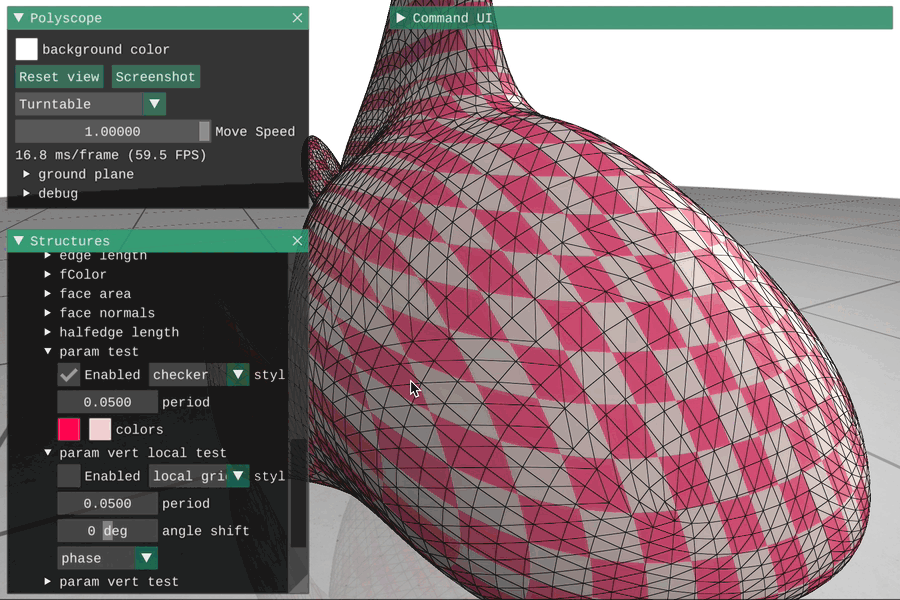Parameterization Quantities
A parameterization is a set of 2D coordinates associated with a mesh, often referred to as “UV coordinates”. This sections details several functions for visualizing such parameterizations.
#include "polyscope/surface_mesh.h"

Example: visualizing an LSCM parameterization via libIGL
using namespace Eigen;
using namespace std;
// Fix two points on the boundary
VectorXi bnd, b(2, 1);
igl::boundary_loop(meshF, bnd);
if (bnd.size() == 0) {
polyscope::warning("mesh has no boundary, cannot parameterize");
return;
}
b(0) = bnd(0);
b(1) = bnd(round(bnd.size() / 2));
MatrixXd bc(2, 2);
bc << 0, 0, 1, 0;
// LSCM parametrization
Eigen::MatrixXd V_uv;
igl::lscm(meshV, meshF, b, bc, V_uv);
polyscope::getSurfaceMesh("input mesh")
->addVertexParameterizationQuantity("LSCM parameterization", V_uv);
Adding
SurfaceMesh::addParameterizationQuantity(std::string name, const T& coords)
Add a new parameterization quantity to the structure, defined at the corners of a mesh.
coordsis the array of 2D UV coordinates at corners. The type should be adaptable to an array offloat-valued 2-vectors. The length should be the number of corners in the mesh.
SurfaceMesh::addVertexParameterizationQuantity(std::string name, const T& coords)
Add a new parameterization quantity to the structure, defined at the vertices of a mesh.
coordsis the array of 2D UV coordinates at vertices. The type should be adaptable to an array offloat-valued 2-vectors. The length should be the number of vertices in the mesh.
SurfaceMesh::addLocalParameterizationQuantity(std::string name, const T& coords)
Add a new parameterization quantity to the structure, defined at the vertices of a mesh. this is similar to addVertexParameterizationQuantity, but has preset settings for style and type which are suitable for local parameterizations about a point.
coordsis the array of 2D UV coordinates at vertices. The type should be adaptable to an array offloat-valued 2-vectors. The length should be the number of vertices in the mesh.
Parameterization Quantity Options
These options and behaviors are available for all types of parameterization quantities on any structure.
Styles
Several styles are available for how a parameterization is displayed.
The enum class ParamVizStyle has options for how parameterizations are visualized:
CHECKER: a two-color checker patternGRID: a grid with thin linesLOCAL_CHECK: a checkboard over a radial colormap, centered around(0,0)LOCAL_RAD: distance stripes over a radial colormap, centered around(0,0)
The function SurfaceParameterizationQuantity::setStyle(ParamVizStyle newStyle) can be used to programmatically change the style.
Types
The enum class ParamCoordsType has options that control how parameter coordinates are interpreted:
UNIT: UV coords are assumed to lie on the[0,1]intervalWORLD: UV coords are assumed to be scaled like the world-space positions of the mesh
These enums can be passed as an optional third argument when a parameterization is registered.
| Parameter | Meaning | Getter | Setter | Persistent? |
|---|---|---|---|---|
| enabled | is the quantity enabled? | bool isEnabled() |
setEnabled(bool newVal) |
yes |
| style | the visualization style (see above) | ParamVizStyle getStyle |
setStyle(ParamVizStyle style) |
yes |
| checker colors | two colors to use for checkerboards | std::pair<glm::vec3,glm::vec3>getCheckerColors() |
setCheckerColors(std::pair<glm::vec3, glm::vec3> colors) |
yes |
| grid colors | two colors to use for line and background of grid | std::pair<glm::vec3,glm::vec3>getGridColors() |
setGridColors(std::pair<glm::vec3, glm::vec3> colors) |
yes |
| checker size | the width of checkers / stripes, always used as a relative value, unless the coord tpe is UNIT |
double getCheckerSize() |
setCheckerSize(double val) |
yes |
| color map | the color map to use for radial displays | std::string getColorMap() |
setColorMap(std::string newMap) |
yes |
(all setters return this to support chaining. setEnabled() returns generic quantity, so chain it last)